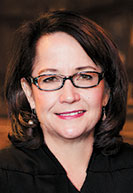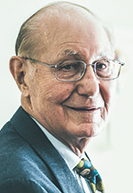Subscriber Benefit
As a subscriber you can listen to articles at work, in the car, or while you work out. Subscribe Now
At the mid-point of his career and with an established practice in aviation law, Alan Farkas sat for the Indiana bar exam in February 2020.
The 51-year-old partner at SmithAmundsen in Chicago got an Indiana law license to better serve his Hoosier clients. As he noted, his entire career was not at stake if he failed so he was not under the same kind of pressure to pass as those who just graduated from law school. Still, he did not want to lose his clients, so he had to put in the time to learn the nuances of the Indiana Code.
Farkas passed and has a positive view of the Indiana bar.
“I felt like I had an opportunity to demonstrate my knowledge and my ability to apply the law,” he said. “I think ultimately that’s what exam is there for. It is a vehicle for applicants to demonstrate their ability.”
The bar exam Farkas took about 10 months ago is about to become a relic.
In November, the Indiana Supreme Court issued an order adopting the Uniform Bar Exam beginning with the July 2021 test. The switch follows the recommendation made by Study Commission on the Future of the Indiana Bar Exam, which took a yearlong review of the state’s law licensing test in 2019.

Indiana Chief Justice Loretta Rush said the justices did their own research into the UBE and talked to law students, law school deans, and bar associations.
They were swayed by the unanimous recommendation from the Indiana Board of Law Examiners to switch to the national test and by the assurances from chief justices in other states that the exam was working well for them. Also, the Indiana justices were convinced by the amount of testing and review the National Conference of Bar Examiners gives to each question on the UBE.
The recommendation from the study commission was not unanimous. Three members of the commission asserted adopting the UBE would erode Indiana’s control over minimal competency standards and bar admittees would not be as well versed in Indiana law.
“I really respect the dissenting opinion and in many ways a lot of us agree with what they are saying,” Rush said. “But we really felt the time had come.”
Indiana essay questions
The only difference between the Indiana Bar Exam and the UBE are the essay questions. Currently, the Indiana Board of Law Examiners writes the six questions that cover one or more of 11 areas of Indiana law.
Under the UBE, the Indiana essay questions will be swapped for the six questions on the Multistate Essay Exam. Otherwise the rest of the Indiana bar will remain the same. The other two sections of the state’s law licensing test — the Multistate Bar Exam, which consists of 200 multiple choice questions and the Multistate Performance Test, which measures fundamental lawyering skills — are part of the UBE.
Bradley Skolnik, executive director of the Office of Admissions and Continuing Education, said the Indiana bar examiners would grade the essay questions on MEE along with the short answers on the MSPE. The National Conference of Bar Examiners provides training to make sure the test is graded consistently across the country
Farkas said the Multistate Performance Test was the best part. This section gives the students a fact scenario and asks them to write a legal memo or a brief. For applicants, Farkas said, they can demonstrate their ability to analyze and think, which aligns with what they will be doing as lawyers.
He struggled with the Indiana essay section because of his limited time to prepare, but he said it was the most valuable because it required the applicant remember and apply Indiana law. Having to write an essay on a particular topic clearly shows whether the individual understands the materials and has the reasoning skills that lawyers need, he said.
Conversely, Farkas found the multiple choice MSBE was “not particularly helpful.” After stumbling on the first practice test, Frakas said he felt he was having to learn more about how to take that section rather than acquiring any knowledge about the underlying information.
As part of the switch to the UBE, Indiana will be developing a separate component that will focus specifically on state law. The Supreme Court is still crafting this, but Rush envisions the Indiana component will be a series of courses on particular subject matters. Also, applicants would be required to complete the courses or they would not be admitted to practice in Indiana.
Rush wants the component to be rigorous.
“I think it is going to be an important component, and I think we’ll have to make that component as strong as we can,” she said. “I’m dedicated to keeping a strong Indiana component. I’m a big believer in Indiana jurisprudence.”

Portability
Having just graduated from Indiana University Maurer School of Law in 1953, Sidney Eskenazi successfully sat for both the Indiana and Illinois bar exams. The now-retired attorney and philanthropist was just entering the profession and was not certain where he would end up practicing.
Like law school, the bar exams were difficult for him. Eskenazi explained he has the learning disability of not being able to remember what he has read. He struggled in law school where, he said, finals were not given until the very end of the school year. He also put in long hours to prepare for the law licensing tests.
His bar exams were all essay questions and he maintains that is good way to measure an applicant’s competency. Consequently, he sees the multiple choice section as the worst part of today’s bar because he believes it only tests an applicant’s memory, rather than lawyer skills, and those who, like him, have trouble recalling material will be at a disadvantage.
“We’re failing a lot of kids,” Eskenazi said, linking the declining bar passage rates to the multiple choice questions. “It shouldn’t be that way.”
Multiple choice is part of the UBE but the test is portable. Applicants who take the national test will have the opportunity to transfer the score and potentially practice in the other states that administer the UBE.
However, admission to another state is not guaranteed.
Skolnik said UBE applicants wanting to practice in Indiana still have to achieve the state’s passing score of 264 on the test and pass the character and fitness examination. They also will have to pass the Indiana component.
Farkas views the bar exam as a necessary to maintain the standards of the profession and protect consumers. By creating a barrier to the legal profession, the test deters individuals who would be inclined to practice law without putting in the effort required.
“I would be terrified what the profession would look like if anybody came out of law school and automatically got a license to practice,” Farkas said. “I think we need to do what we can as a profession to ensure the lawyers have minimum competency.”•
Please enable JavaScript to view this content.
